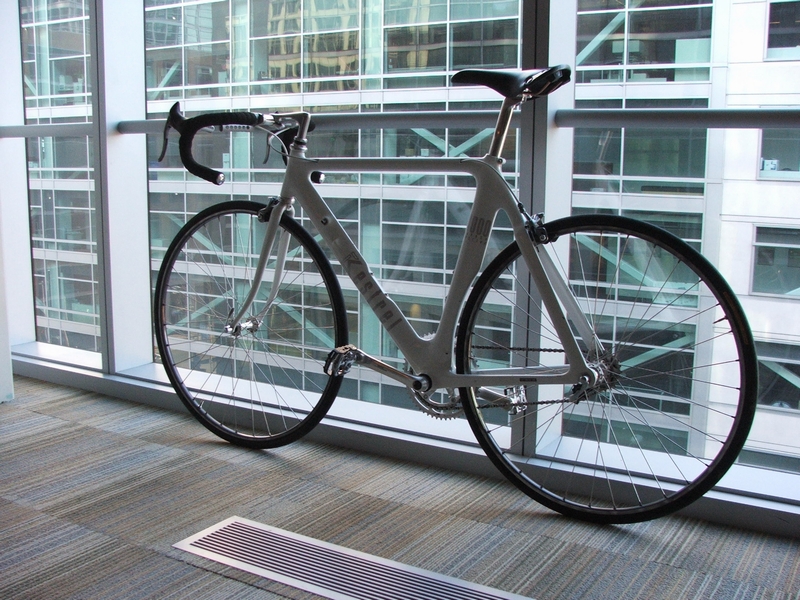
1990 Kestrel
4000
Part Diary,
Part Technical Manual, Part Tips & Tricks
The Kestrel 4000 was the
first production monocoque carbon fiber frame, introduced in 1986 as a 1987
model. Ever since it was produced, I loved the way the bike looked, but the
price was WAY too steep for me in high school. Even today, I can't really think
of a more graceful looking bicycle. Unfortunately the new Kestrels are now made
in China and have an angular look, instead of the old smooth designs. Interesting
how the new Cervelo Soloist Carbon looks alarmingly like a 4000 made 20 years
ago.
These 4000s are surprisingly hard to find, so after months of looking, I found
one on eBay. I won the bid on June 4, 2007.
The package arrived a few weeks later, containing the frame, fork, Dura-Ace
bottom bracket, and Wolber rims laced to Shimano 600 hubs. I'm guessing this is a 1990 model, based on the newer style grey decals.
6/1/09 - After almost two years, I decided to sell the frame and fork, after I transfered most of the parts onto my Bianchi Krono. It was a very nice bike to own, with the carbon frame and the aluminum fork, it's the most comfortable road bike I've ever ridden. Sold it to a nice guy in San Leandro.
Frame: 1990 Kestrel
4000 Spectra, 52.5cm CTC. Serial Number: 12473. The
frame has a large hole at the base of the bottom bracket (pic).
I was told that the seat tube was formed by inflating a bladder and laying carbon
fiber over it. After the carbon fiber cured, the bladder was pulled out through
this hole. In later models, there is no hole, they just left the bladder in
the frame.
Fork: Kestrel 1" threaded, aluminum.
Wheels: Wolber T430 Alpine, Chrome Magnesium with hard anodized finish.
Front Hub: Shimano 600, HB-6400.
Rear Hub: Shimano 600, FH-6400, Uniglide.
Tires: Continental Ultra 2000, 700 x 23C.
Cassette: Shimano 7spd
Hyperglide 13-25T. This was complicated, the gruppo originally game with a Uniglide
12-24T cassettte, but the
middle three sprockets are worn and caused the chain to hop. After reading this article by Sheldon
Brown, I realized that I could just simply flipped the sprockets around and
now it rides fine. That worked fine, but I wanted to get slightly lower gearing,
so I installed a new 7spd Hyperglide cassette body, which opens up a lot more
possibilities, as HG cassettes are very common, but UG cassettes are getting
pretty hard to find.
Cranks: FSA Vero
Compact, 50x34, 170mm, 110 BCD. Cold-forged AL6061/T6 alloy with polished
black anodized finish.
Bottom Bracket: Shimano Dura-Ace BB-7400, 112mm spindle, NJS approved.
Front Derailer: Interloc Racing Design (IRD) CD,
braze-on, bottom pull. This front derailer accommodates the larger jump on compact
chainrings that standard derailers cannot handle.
Rear Derailer: Shimano 600 RD-6400.
Shifters: Shimano 600.
Headset: Shimano
600.
Chain: SRAM
PC 48 8spd.
Stem: Nitto 1" quill, 100mm, cold-forged aluminum.
Handlebar: Nitto B115, 420mm width, 140mm drop, 100mm reach, aluminum
alloy.
Extensions: Cinelli Spinaci
Light.
Brakes: Shimano
600 BR-6400.
Levers: Shimano 600 BL-6401.
Pedal: Shimano PD-M520 SPD.
Seatpost: Shimano
600 SP-6400, 27.2mm, NOS that I got from Vicenza, Italy!
Saddle:
Selle San Marcos Regal Girardi, leather with copper plated steel rails.
Gearing with compact crankset
|
Ratio |
13 |
15 |
17 |
19 |
21 |
23 |
25 |
|
50 |
7.6 |
6.5 |
5.8 |
5.2 |
4.7 |
4.3 |
3.9 |
|
34 |
5.1 |
4.5 |
3.9 |
3.5 |
3.2 |
2.9 |
2.7 |
Gearing
with standard crankset
|
Ratio |
12 |
13 |
15 |
17 |
19 |
21 |
24 |
|
53 |
8.5 |
7.9 |
6.8 |
6.0 |
5.4 |
4.9 |
4.3 |
|
39 |
6.3 |
5.8 |
5.0 |
4.4 |
4.0 |
3.6 |
3.1 |
The bike currently weighs 22lbs 5oz as shown. The frame weighs 4lbs 3oz. The fork weighs 1lb 4oz.
The following are OE parts that I am currently not using:
Saddle: Selle San Marcos Regal Girardi, leather with copper coated steel rails.
Front Derailer: Shimano 600 FD-6400, braze-on.
Cranks: Shimano 600 FC-6400, 53x39, 172.5mm, 130 BCD.